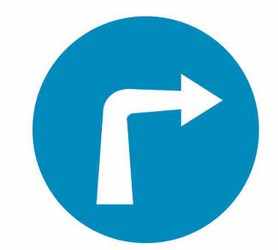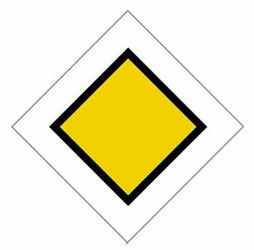QUESTION 1
QUESTION 1
What does this traffic sign mean?

Turn right ahead.
Dangerous right bend ahead.
Compulsory passage only from the right side of the traffic island or obstacle.

QUESTION 2
QUESTION 2
What does this traffic sign mean?

End of priority road.
Priority road.
Give priority.

QUESTION 3
QUESTION 3
At vehicle braking under normal circumstances, on what does braking distance depend mainly?

The pressure you exert on the footbrake pedal.
The kind of the braking system.
The speed of the vehicle.

QUESTION 4
QUESTION 4
Which is the maximum permissible speed limit for buses in expressways, when this is not specified by special traffic signs?

80 km/h.
90 km/h.
100 km/h.

QUESTION 5
QUESTION 5
When a bus breaks down in a provincial road network, at what distance should the driver place the warning triangle:

At a distance of at least 100 m.
At a distance of at least 50 m.
At a distance of at least 20 m.

QUESTION 6
QUESTION 6
The speed limiter device is fitted to buses, in pursuance of the directive 92/6/EEC, and restricts their speed to?

90 km/h.
100 km/h.
110 km/h.

QUESTION 7
QUESTION 7
The maximum length of an articulated bus is:

15,00 m.
16,00 m.
18,75 m.

QUESTION 8
QUESTION 8
In a suspension system with air, what is the use of the high pressure circuit:

It maintains the pressure in the air springs steady.
It supplies additional air to, and increases the pressure in the air springs, when the car is being loaded, so as to maintain it steady.
It supplies air to the servo-mechanisms of the vehicle.

QUESTION 9
QUESTION 9
The oil springs are designed:

Not to allow the combustion gases to escape to the crankcase.
Not to allow the lubrication oil to reach the combustion chamber.
To lubricate the distributor.

QUESTION 10
QUESTION 10
You notice that the diesel engine of your bus, while started, stops after a few revolutions. What may the cause of this be?

Low compression of the cylinders.
Obstruction of the feeding system.
Improper internal timing of the injection pump.

RESULTS-
ΕΡ
TR
ΕΠ
RESULTS
SECTION

